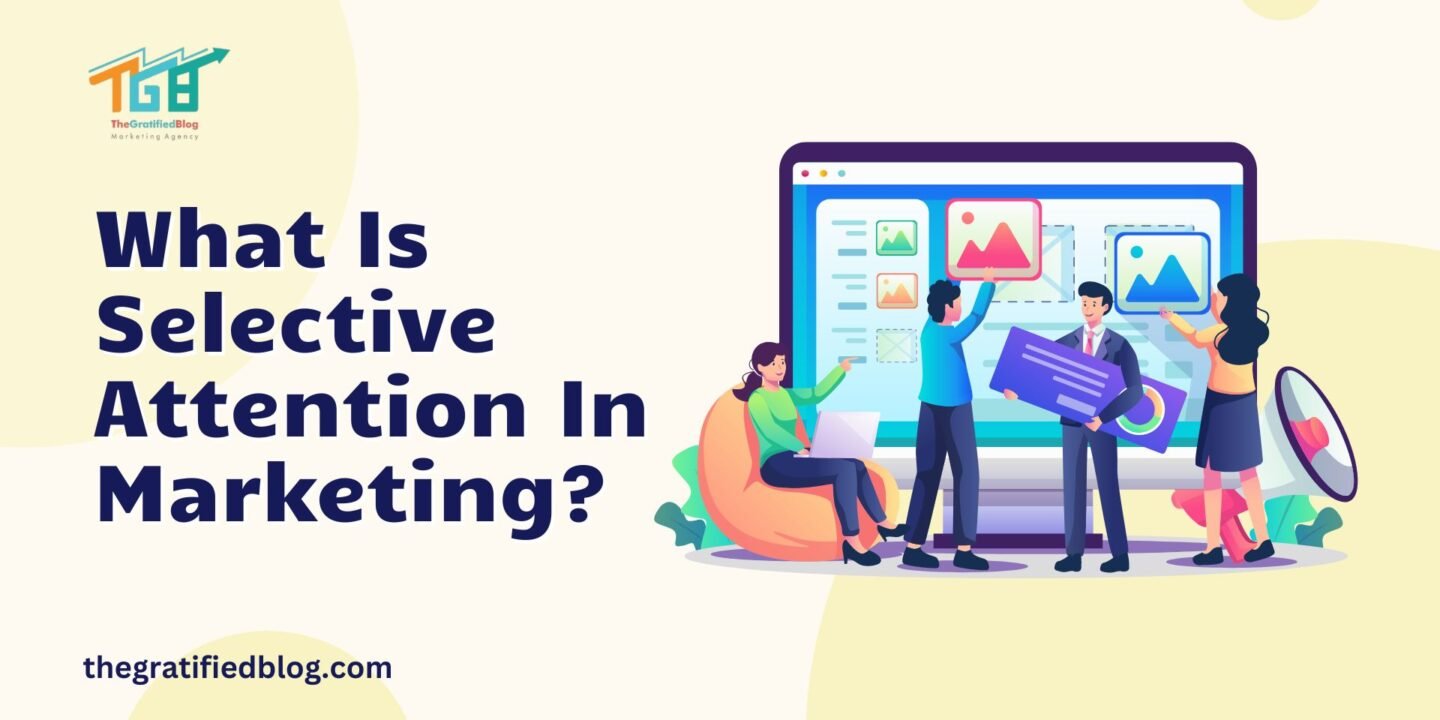
Selective attention in marketing refers to the process by which consumers focus on specific information and filter out irrelevant details when exposed to various advertising messages. This concept is crucial in understanding consumer behavior and designing effective marketing strategies to capture their attention. By understanding how selective attention works, marketers can create targeted campaigns that resonate with their target audience and drive successful outcomes. In this blog, “What is selective attention in marketing?” we will delve deeper into the concept of selective attention and explore its significance in the highly competitive business landscape.
What Is Selective Attention In Marketing? Understanding Its Concept

To grasp the concept of selective attention in marketing, it is essential to acknowledge the cognitive processes that influence consumers’ choices. This mechanism allows individuals to focus on specific stimuli while disregarding others, thus shaping their perception of brands and products.
Marketers can tailor their messaging to align with consumers’ preferences and values by comprehending how selective attention operates. Businesses can use this principle strategically to increase brand awareness, engagement, and conversions. Here’s a breakdown of the concept:
- Filtering: Selective attention acts as a filter, allowing certain stimuli to pass through while blocking others. This filtering mechanism prevents sensory overload and helps individuals prioritize relevant information.
- Limited Capacity: The human brain has limited cognitive resources. Selective attention helps allocate these resources efficiently by directing them toward the most important or salient stimuli at any given moment.
- Top-down and Bottom-up Processing: Selective attention can be influenced by both top-down (internally driven) and bottom-up (externally driven) factors. Top-down processes involve higher-level cognitive factors, while bottom-up processes involve stimuli’s salience or inherent characteristics.
- Attentional Control: Selective attention involves consciously controlling and directing one’s attention. This control allows individuals to focus on tasks, goals, or stimuli relevant to their current objectives.
- Inattentional Blindness: Selective attention can lead to inattentional blindness, where individuals fail to notice unexpected stimuli because their attention is focused elsewhere. This highlights the limitations of selective attention and the importance of being aware of potential distractions.
- Attentional Spotlight: Selective attention can be likened to a spotlight that can be directed to different areas of perception. This spotlight can shift rapidly in response to environmental changes or task demands.
- Cognitive Load: Cognitive load can influence selective attention, with individuals experiencing more difficulty maintaining focus when concurrent tasks or distractions tax cognitive resources.
Selective attention is a crucial cognitive mechanism that allows individuals to navigate their environment, process information efficiently, and achieve their goals amidst competing stimuli. Understanding how selective attention operates can provide insights into human perception, cognition, and behavior.
How Selective Attention Affects Consumer Behavior
Selective attention is pivotal in influencing consumer behavior by directing their focus toward certain marketing stimuli. Consumers are bombarded with myriad advertisements daily, making it crucial for marketers to understand how selective attention can impact their decision-making process. By strategically capturing consumers’ attention through compelling visuals, personalized messaging, and unique value propositions, businesses can increase the likelihood of converting prospects into loyal customers.
Understanding the psychology behind selective attention empowers marketers to craft targeted campaigns that resonate with their target audience, ultimately driving brand engagement and fostering long-term relationships. Selective attention plays a crucial role in shaping consumer behavior in various ways:
- Brand Recognition: Selective attention influences consumers’ ability to recognize and recall brands. Consumers are likelier to notice and remember brands that align with their interests, needs, or preferences.
- Advertising Effectiveness: Consumers selectively attend to advertisements based on relevance, novelty, or emotional appeal. Advertisers use attention-grabbing techniques, such as vivid imagery, compelling storytelling, and celebrity endorsements, to capture consumers’ attention and increase the likelihood of message retention.
- Product Placement: Selective attention influences consumers’ perception of product placement in various media channels, including movies, television shows, and social media.
- In-Store Decision Making: Selective attention affects consumers’ in-store decision-making processes, guiding their attention toward specific products, promotions, or displays.
- Online Shopping Behavior: In the digital era, selective attention shapes consumers’ online shopping behavior by directing their focus toward specific products, websites, or marketing messages.
- Consumer Decision-Making: Selective attention influences consumers’ cognitive processes and decision-making heuristics, such as information processing, risk perception, and choice evaluation.
Selective attention shapes consumer behavior by influencing perception, memory, and decision-making processes across various consumer journey stages. Marketers and retailers must understand how attentional mechanisms operate to design effective strategies that capture consumers’ attention, enhance brand engagement, and drive purchase behavior in an increasingly competitive marketplace.
Strategies To Capture Consumer Attention
In the bustling marketing world, capturing consumer attention is vital for a brand’s success. To effectively leverage selective attention, marketers can employ various strategies. Utilizing eye-catching visuals, crafting compelling storytelling, and incorporating interactive marketing elements are proven methods to engage consumers. Personalization through targeted messaging tailored to specific demographics and preferences can also enhance the likelihood of capturing attention.
Moreover, leveraging social proof, such as customer testimonials and reviews, can build credibility and attract consumers’ focus. By thoughtfully integrating these strategies, businesses can cut through the marketing clutter and effectively connect with their target audience.
Selective Attention Important In Marketing
Selective attention plays a crucial role in enhancing marketing effectiveness. By understanding how consumers selectively focus on specific stimuli over others, marketers can tailor their strategies to capture and retain attention. Crafting compelling and relevant content, utilizing captivating visuals, and personalizing messages to target audience interests are vital components in harnessing selective attention for marketing success.
Moreover, integrating social proof and interactive elements can further engage consumers and drive brand recognition. In the competitive marketing landscape, mastering the art of selective attention is essential for standing out and forging meaningful connections with your audience.
Examples Of Successful Marketing Campaigns Using Selective Attention
Examples of successful marketing campaigns utilizing selective attention often highlight the power of understanding consumer preferences and behavior. For instance, Coca-Cola’s “Share a Coke” campaign personalized its product by featuring popular names on its bottles, effectively capturing the attention and engagement of its audience. Similarly, Nike’s “Just Do It” slogan resonates with individuals’ desires for motivation and empowerment, cutting through the marketing noise with a simple yet powerful message.
These examples demonstrate how strategically using selective attention can elevate brand visibility and connection with consumers. By studying successful campaigns, marketers can glean valuable insights into implementing selective attention techniques in their strategies for optimal results.
Conclusion
In conclusion, selective attention in marketing is a powerful tool that allows brands to capture the interest of their target audience amidst the plethora of information available today. By understanding consumer preferences and behavior, brands can create relevant and engaging campaigns that resonate with their audience. The success stories of Coca-Cola and Nike exemplify how utilizing selective attention can lead to heightened brand visibility and stronger consumer connections.
As marketers, studying such successful campaigns to gain insights into incorporating selective attention techniques into our strategies for maximum impact is crucial. Remember, by focusing on what matters to the consumer, we can create meaningful and effective marketing campaigns that drive results.








No Comments